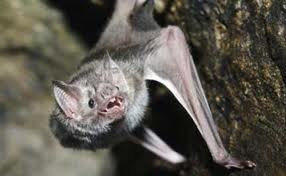Common vampire bat
A species of Vampire bat Scientific name : Desmodus rotundus Genus : Vampire bat
Common vampire bat, A species of Vampire bat
Scientific name: Desmodus rotundus
Genus: Vampire bat
Content
Description General Info
 Photo By blog.seniorennet.be , used under CC0 /Cropped and compressed from original
Photo By blog.seniorennet.be , used under CC0 /Cropped and compressed from original Description
The common vampire bat is short-haired, with silver-gray fur on its undersides, demarcated from the darker fur on its back. It has a deeply grooved lower lip, and a flat, leaf-shaped nose. A well-developed, clawed thumb on each wing is used to climb onto prey and to assist the animal in take-off. The bat averages about 9 cm (3.5 in) long with a wingspan of 18 cm (7 in). It commonly weighs about 25–40 grams (2 oz), but its weight can drastically increase after a single feeding. The braincase is relatively large, but the snout is reduced to accommodate large incisors and canines. It has the fewest teeth among bats. The upper incisors lack enamel, which keeps them razor-sharp. Its dental formula is 1.1.2.01.1.3.0, for a total of 18 teeth. While most other bats have almost completely lost the ability to maneuver on land, vampire bats are an exception. They can run using a unique, bounding gait in which the forelimbs are used instead of the hindlimbs to propel forward, as the wings are much more powerful than the legs. This ability likely evolved independently within the bat lineage. Three pads under the thumb function like a sole. It is also capable of leaping in various directions, heights, and distances. When making a jump, the bat pushes up with its pectoral limbs. The hindlimbs keep the body over the pectoral limbs which are stabilized by the thumbs. Common vampire bats have good eyesight. They are able to distinguish different optical patterns and may use vision for long-range orientation. These bats also have well-developed senses of smell and hearing: the cochlea is highly sensitive to low-frequency acoustics, and the nasal passages are relatively large. They emit echolocation signals orally, and thus fly with their mouths open for navigation. They can identify a metal strip 1 centimetre (0.39 in) wide at a distance of 50 centimetres (20 in), which is moderate compared to other bats. 
General Info
Lifespan
9-12 years (wild), 19.5-20 years (captivity)
Diet
Common vampire bat is a hematophagous organism, subsisting entirely on blood meals from warm-blooded hosts. Its preferred targets include large mammals such as cattle, horses, and occasionally humans. This highly specialized diet involves a meticulous feeding approach, avoiding major vessels and minimizing host distress to remain unnoticed.
Appearance
Common vampire bat is a small, compact mammal with a body shape similar to a furry rodent. It has smooth, short black or dark brown fur throughout, except for paler underparts. Its most characteristic features include a wide, flat, cow-like head, a short muzzle, and large, pointed ears. The common vampire bat also possesses a pair of well-developed wings and a short, bumpy tail. There are no significant differences in appearance across age, gender, or subspecies.
Behavior
Common vampire bat are nocturnal, feeding on the blood of other animals. They are known for their intricate social structure, often roosting in colonies that display co-operative behavior. Unusual among mammals, common vampire bat have been observed sharing food, particularly with kin. They mark their territories using scent from specialized glands. Adapted to a hematophagic diet, common vampire bat possesses anticoagulant saliva, aiding them in their unique feeding protocol.
Population
Stable
Scientific Classification
Phylum
Chordates Class
Mammals Order
Bats Family
Leaf-nosed bat Genus
Vampire bat Species
Common vampire bat